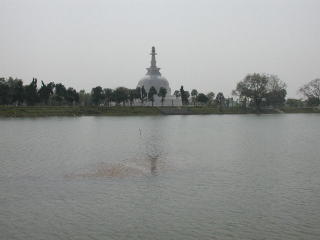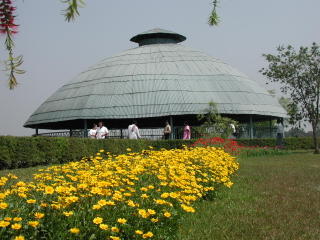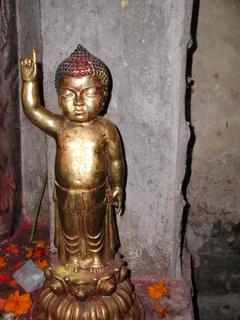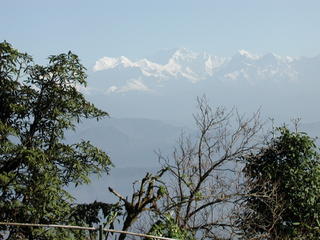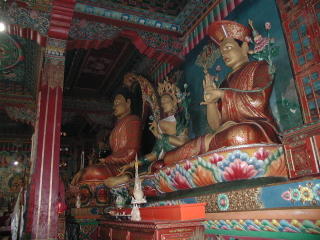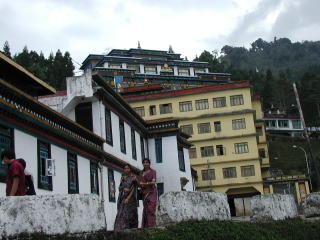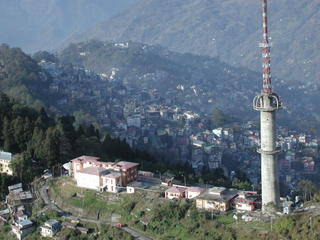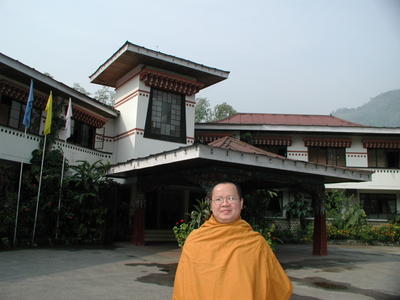

Bodh Gaya, the Site of the Buddha’s Enlightenment
I. Location and Historical Importance
The shrine of Bodh Gaya is the place where the Buddha reached Enlightenment in 528 B.C. while meditating under a bodhi tree. (A good account of the history of Bodh Gaya is contained within Middle Land, Middle Way; A Pilgrim’s Guide to the Buddha’s India, by Ven. S. Dhammika, pp. 43-57. This source was used in the preparation of the material here. Cf., also, Buddha Gaya Temple; Its History, by Dipak K.Barua, pp. 10-157.) Bodh Gaya is near the present-day village of Urel, the ancient town of Uruvela, in the state of Bihar in India, the Gaya district. Bodh Gaya is almost seven and a half miles south of Gaya (also Brahma Gaya). It is about fifty-six miles south of Patna and about one hundred forty-two miles east southeast of Varanasi. Bodh Gaya adjoins the Neranjara River (called today Nilajan or Lilajan), which meets the Mohana downstream to form the Phalgu River flowing past Gaya. Uruvela refers to the sand (vala) in the area. The name of the town became disused, and the site was called Sambodhi by Great King Asoka, later Mahabodhi, Bodhimanda, and Vajrasana (the Diamond Throne), finally, in the seventeen hundreds, Bodh Gaya, as distinct from (Brahma) Gaya. After the Enlightenment the Buddha spent forty-nine days in the vicinity of Uruvela. Later the same year he returned to convert three famous ascetics, Gaya Kassapa, Nadi Kassapa, and Uruvela Kassapa, who lived nearby. Thereafter, the Buddha apparently never came back to the place of his Enlightenment.
The history of Bodh Gaya is of the utmost interest. Bodh Gaya originally consisted of probably no more than the bodhi tree, the stone slab marking the place where the Buddha was meditating, and a railing around both. It is assumed that King Asoka built a temple there, presumably the one depicted in the relief at the Bahrhut stupa The history of Bodh Gaya can be traced by examining the inscriptions made at the site and the accounts given by pilgrims. For example, Huien Tsiang, who visited the place in the early part of the seventh century, describes the monastery there as well as the Mahabodhi Temple, originally built probably in the early fourth century and appearing in the seventh much as it does today. Bodh Gaya and the Mahabodhi Temple flourished during the extended rule of the Bengalese Pala kings, who reigned from about 700 A.D. to 1161 A.D. During this time, too, in the early part of the eleventh century, important pilgrims came from such places as China and Tibet, e.g., the Tibetan translator Rinchen Sangpo. Bodh Gaya, it seems, had become not only an important shrine but also a center of learning. Between the early 300s, on the one hand, and the early 1200s, the time of Muslim attacks, on the other, the kings and monks of Sri Lanka maintained and expanded Bodh Gaya. After the attacks Bodh Gaya, abandoned and forgotten, fell into ruins. Buddhism had all but disappeared in India. As the Sri Lankans had cared for the Mahabodhi Temple for the nine hundred years before the Muslims overran the area, so for about six hundred years after the attacks the kings of Burma, ironically enough, preserved the temple by sending at least six missions to repair it, the first in 1295 and the last in 1877. In 1880 J. D. Beglar, under the auspices of Alexander Cunningham, the father of Indian archeology, restored the temple. In the late 1800s Anagarika Dharmapala, the founder of the Maha Bodhi Society began disputing the claims of the mahant (the Hindu headman) who resided at Bodh Gaya to the Maha Bodhi Temple. In 1949, at last, following public support by Rabindranath Tagore and Mahatma Gandhi, the Bodh Gaya Temple Act established a committee of four Hindus and four Buddhists to tend to the affairs of the temple. This arrangement is less than desirable, especially since, according to the Act, the district magistrate of Gaya, presumably a Hindu, is the ex-officio chairman of the committee. Furthermore, should it happen that the magistrate is not a Hindu, the state government must still nominate a Hindu as chairman of the committee (cf. Barua, Buddha Gaya Temple, Appendix Four, “The Bodh Gaya Temple Act, 1949,” secs. 4-6, p. 289). In June of 2002 the Maha Bodhi Temple was added to UNESCO’s World Heritage list as a cultural landmark having outstanding universal value.
II. The Story of the Buddha’s Enlightenment
and its Significance
After the future Buddha, Siddhartha Gotama, left his home in search of Enlightenment, he went to Rajagaha, then to Giribbaja of the Magadhans to go an an alms walk (cf. The Group of Discourses (Sutta-Nipata), trans. by K. R. Norman, III.1, “Going forth,” p.50). King Bimbisara saw him and sent messengers to find out where he was going. Siddhartha went to Mount Pandava to dwell in a cave. The king went to see him and asked whence he came. Siddhartha told the king he had come from an area near the Himalayas, being of the Adicca clan, the Sakiya dynasty. The king promised to make his life easy, but Siddhartha said he saw a danger in a life of sensuous pleasures and intended to strive for something better.
Siddhartha, seeking a life of peace, went to Alara Kalama and expressed a desire to learn his Sankhya philosophy. Siddhartha mastered this branch of learning. He eventually realized that Alara Kalama’s teaching did not lead to Enlightenment and left, looking for something better. Next he went to Uddaka Ramaputta and told him he wanted to learn his doctrine. Once again, though, he realized the teaching did not lead to Enlightenment, and he left. (Cf. the “Ariyapariyesana Sutta: The Noble Search,” Number 26, in The Middle Length Discourses (Majjhima Nikaya), 14-17. Cf. sections 13-30 of the same sutta, where the Buddha recounts the story of his search for Enlightenment from his early experiences with the ascetics to his conversion of the five bhikkhus at Deer Park. Cf. Number 36, the “Mahasaccaka Sutta; The Great Discourse to Saccaka,” Middle Length Discourses. Sections 13 through 16 of this sutta repeat sections 14-17 of Number 26 in a new setting.)
So Siddhartha wandered through the Magadhan country until reaching the vicinity of Uruvela. Here he spent six years in extreme asceticism accompanied by five bhikkhus (Kondanna, Vappa, Assaji, Mahanama, and Bhaddiya). He eventually realized that there was nothing wrong with eating a reasonable amount of food (cf. the Mahasaccaka Sutta, Middle Length Discourses, No. 36:32). The five bhikkhus left, thinking Siddhartha was now living a life of luxury. Siddhartha went to meditate under a bodhi tree near Uruvela close to the banks of the Neranjara River. While he was meditating he was tempted by Mara (Namuci), death, the evil tempter, who tried to dissuade him from his efforts (cf. The Group of Discourses (Sutta-Nipata), trans. by K. R. Norman, III.2, “Striving” (also called Padhana Sutta), pp. 51-53). The armies of Mara (sensual pleasures; discontent; hunger and thirst; craving; sloth and torpor; fear; doubt; hypocrisy and obstinacy; and gain, renown, honor, false fame, extolling of self and disparagement of others) were no match for the mindfulness of the Blessed One (cf. the Padhana Sutta, pp. 52-53; cf. the “Marasamyutta; Connected Discourses with Mara,” in The Connected Discourses of the Buddha (Samyutta Nikaya), I.4.24, “Seven Year of Pursuit” (Mara pursues the Buddha for six years prior to the time of his Enlightenment and for one year thereafter”; and I.4.25, “Mara’s Daughters” (Mara’s daughters, Tanha, Aranti, and Raga, try different tactics to tempt the Buddha)). In his meditation he passed through the first and second jhana to the “third true knowledge” of Enlightenment (cf. the Mahasaccaka Sutta, 36:34-44; cf. the Ariyapariyesana Sutta, 26:18). He became the Buddha.
The meaning of Enlightenment, i. e., Nibbana, is coolness (cf. the discussion in “Nibbana for Everyone,” by Buddhadas Bhikku, p. 4ff.). In other words Nibbana is being “cool and collected,” not “hot and bothered.” The Buddha’s achievement of Enlightenment is described in different ways in the suttas. For example, in the Ariyapariyesana Sutta, 26:19, reaching Enlightenment is cast in terms an understanding of specific conditionality and dependent origination, as well as of such truths as the destruction of craving. In the Mahasaccaka Sutta, 36:42, the liberation of Enlightenment is understood in terms of an understanding of the Four Noble Truths. In the “Mahapadana Sutta: The Great Discourse on the Lineage,” in The Long Discourses of the Buddha (Digha Nikaya), II:14.2.18-2.22, the “insight (vipassana) way to enlightenment” (2.21) (italics mine) is the realization of dependent origination, and sainthood (the state of the arahant) is the contemplation of the rising and falling of the five aggregates in all their complexity (2.22). In the “Nidanasamyutta; Connected Discourses on Causation,” in The Connected Discourses (Samyutta Nikaya), II.12.65, the path to Enlightenment is associated with ceasing of name and form, hence, ceasing of consciousness.
After reaching Enlightenment, the Buddha, considering the difficulty of the teaching, the Dhamma, he had discovered, was not inclined to share it with others (cf. the Ariyapariyesana Sutta, 26:19-21; cf. the Mahapadana Sutta, II:14, 3.1-3.7). However, the Brahma Sahampati, telling the Buddha there would be those who would understand and would benefit, convinced him of the importance of spreading the Dhamma.
III. Archeology and Monuments
Bodh Gaya is a place of important Buddhist monuments, including the gateway, the railing, the Buddhapada Temple, the Mahabodhi Temple, the Bodhi Tree, the outer Vajrasana, the Ratanacankama Chaitya, the Ratanaghara Chaitya, and the Asoka pillar. The most important of these is the Mahabodhi Temple (cf. the discussion in Dhammika’s Middle Land, Middle Way, pp. 47ff., 58-62, the primary source for the following; and cf. the extensive discussion in Barua’s Buddha Gaya, notably, pp. 158-182, the discussion of art and architecture).
The original Mahabodhi Temple, the same structure that exists today, probably dates from 300 to 350 A.D. It is the temple of the “great Enlightenment” (cf. maha, great; bodhi, Enlightenment). There is no pilgrim’s report of it in the early 300s; there is a report of it in the early 600s. There is no existing inscription indicating who the donator was. The base of the temple is a large rectangle 50 feet square, atop of which in the middle sits a large spire (sikhara), an obelisk with the top pyramid cut off. Four similar, smaller spires sit at each corner. The main spire, almost 171 feet high, is capped by a flat, round structure, the amalaka, above which is a tower called the kalasha, both comprising the stupa. The temple was constructed almost entirely of bluish bricks with a plaster coating, the bricks in the oldest parts fitting together so well almost no cement was used. The two niches on either side of the main entrance in times past contained silver statues of Avalokitesvara and Maitreya; today they contain statues of the Buddha. The first chamber of the temple is noteworthy insofar as the floor contains crude carvings from the first third of the fourteenth century of figures with hands in the anjali mudra (hands folded at the heart). The next room, a large room with the ceiling vault shaped like a barrel, has the shrine at the end. At this place is the exact spot, the “Navel of the Earth,” the Vajrasana, the Diamond Throne (from vajrasa, diamond, and asana, seat or sitting), where the Buddha attained Enlightenment. Cunningham discovered a second shrine behind the stone slabs, one presumably dating from about 160 A.D. Moreover, a third shrine, the earliest, was also discovered. This latter shrine is thought to have contained the original Vajrasana, one similar to the one depicted in the relief from the Bahrhut stupa. (This stupa, about ninety-four miles from Jabalpur, which is east southeast of Bodh Gaya, dates from 250-150 B.C. It contained many historic scenes, and pieces of sculpture having inscriptions with lettering similar to that on the Sanchi stupa. Cf. D. C. Ahir, Buddhism in Modern India, pp. 56-57.) It is thought this Vajrasana, with a smooth, broken sandstone slab; pedestal; and four pilasters at the front, was part of Asoka’s original temple, although the sandstone slab might be even older. The Buddha statue at the shrine today dates from the late 900s. (Cf. Shanti Swaroop Baudah, Bodhgaya; The Great Sacred Place of Buddhists, p. 82, who claims, mistakenly, that the Buddha statue in the sanctum sanctorum of the Mahabodhi Temple was placed there in 380 A.D.) More than six and a half feet high and featuring the Buddha in the earth-touching posture, this statue was moved to the temple by Cunningham from the mahant’s palace. The previous statue, more impressive and moving than the current one, was likely destroyed during the Moslem invasion.
At the rear of Mahabodhi Temple (the western end, the inner shrine side) is the Bodhi tree, like the one under which the Buddha achieved Enlightenment. The bodhi (bo tree) is a variety of fig tree (bodhirukkha, ficus religiosa; the Indian fig tree, peepul/pipal/peepal). King Sasanka of Bengal dug up the original tree about 600 A.D. and burned it. A supporter of the Hindu religion of Siva-Mahesvara, he persecuted Buddhists and slandered the Buddhist religion out of envy (cf. Buddha Gaya, Barua, p. 229). The original Bodhi Tree was moved a little westward when the Mahabodhi Temple was built. In 1876 the remaining part of the tree existing at that time fell down, and Cunningham planted a sapling from the tree. In 1880 Cunningham, digging near the new Bodhi Tree, discovered at a depth of about three feet what he thought were two pieces of the tree destroyed by King Sasanka.
The shape of the bodhi tree leaf became a common motif in Buddhist (and even Hindu) architecture (cf. Baudah, Bodhgay,, pp. 90-92, the figures). For example, the main entrance to Ajanta includes the bodhi tree leaf pattern. Furthermore, such statues of the Buddha as the one in the Thai temple at Bodh Gaya feature the same leaf pattern: the crest of the leaf becomes the point of the Buddha’s crown, and the two cut-away lower parts of the leaf, relocated at either side, become the Buddha’s ears (cf. the picture in Baudah, Bodhgaya, p. 111).
At the base of the present-day Bodhi Tree lies the outer Vajrasana, probably from King Asoka himself. This one, made from polished Chunar sandstone and measuring about fifty-six inches by ninety-four inches by thirty-six inches high, has a palmette (decoration like a palm leaf) and goose design similar to the one on the king’s pillar capital at Sanchi. In early Buddhism the goose (hamsa) was the symbol of detachment. There seems to be some disagreement as to which Vajrasana, the outer one or the one inside the temple, is the exact place where the Buddha attained Enlightenment. However it would seem clear enough that the Vajrasansa inside the temple marks the precise spot. (Cf. Ahir, Buddhism in Modern India, p. 44, who says, “The Vajrasana . . . seen between the Bohdi Tree and the Temple marks the actual spot . . .” Yet discussions about the inner Vajrasana in Dhammika’s Middle Land, Middle Way, pp. 59-60, and in Barua, Buddha Gaya Temple, pp. 29-31, would seem to indicate otherwise.)
Like the other holy Buddhist sites, Bodh Gaya was graced by one of Great King Asoka’s pillars. In this case what remains of a pillar is located to the right of the east gate to the Mahabodhi Temple grounds. If the Bahrhut stupa relief is any indication, Asoka’s pillar, just outside the temple railing to the right of the entrance, had an elephant capital. Curiously enough, neither Fa Hien (early fourth century) nor Huien Tsiang (early seventh century) mentioned seeing any pillar at Bodh Gaya. The pillar currently at the site was moved there from Gol Patthar in Gaya in 1956.
Other monuments of note at Bodh Gaya include the gateway, the railing, the Buddhapada Temple, the Ratanacankama Chaitya, and the Ratanaghara Chaitya. The beautifully carved gateway to the Mahabodhi Temple dates from about the 700 A.D. Interestingly enough, at the base there are two figures of Burmese craftsmanship, probably from the 1811 mission. The railing surrounding the temple was originally a wooden structure. About 100 B.C. a stone railing replaced the wooden one. The present-day stone railing, constructed sometime around the 500s, contains pieces of the old stone, brown in color and smooth compared to the newer gray and rough. The Buddhapada Temple is significant because its portico has carved footprints symbolic of the Buddha. The Ratanacankama Chaitya, the so-called “Jewel Promenade Shrine,” is the place where the Buddha walked in the third week after his Enlightenment. The Ratanaghara Chaitya, lastly, the “Jewel House Shrine,” is the place where it is said the Buddha stayed the fourth week after the Enlightenment meditating on the Abhidhamma, the third “Basket.” The oldest monuments at Bodh Gaya, the earliest temple structures, are the remains of the Ratanacankama Chaitya, the Vajrasana, the Bodhi Tree, and the railing (the brown, smooth stones).
IV. Conclusion: Bodh Gaya Today
Despite the fact that Bodh Gaya barely survived the ravages of time and history and sectarianism, it has become an important tourist spot and pilgrimage stop (for the following, cf. Baudah, Bodhgaya, especially pp. 109-123). Sculpture and architecture are once again flourishing at the site in a way they have not for a century and a half. An indication of this was the construction from 1984 to 1989 by the Japanese Daijokyo sect of the eighty-foot-high Buddha statue, the second highest statue in India. The Dalai Lama himself unveiled this statue in November of 1989.
Numerous temples have been constructed in recent times at Bodh Gaya. The most important of these, second only in splendor to the great Mahabodhi Temple itself, is the Wat Thai (Wat Bodhgaya). Completed in 1957 and renovated in 1970 to 1972, this temple is as beautiful as its counterpart in Thailand. Its most distinctive feature, not to mention its orange roof, is the beautiful Buddha statue inside, measuring almost twelve feet in height. The statue includes the bodhi tree leaf motif. Bodh Gaya today also includes the following temples: the Burmese Buddha Vihara, popular with foreigners with ample accommodations; the Indosana-Nipponji (Japanese); the Daijokyo (“great Vehicle,” “Mahayana”) Buddha Vihara; the Geluppa and the Karamepa Tibetan Buddha Viharas; the Bhutanese Buddha Vihara (Bhutan is a small kingdom in the Himalayan Mountains); the Chinese Buddha Vihara; and the Vietnamese, Korean, Bangladeshi and the Taiwanese Buddha Viharas.
December 6, 2005


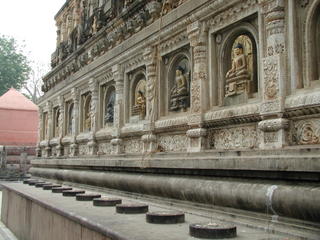 พระมหาเจดีย์พุทธคยา หรือพระวิหารมหาโพธิ์
พระมหาเจดีย์พุทธคยา หรือพระวิหารมหาโพธิ์
